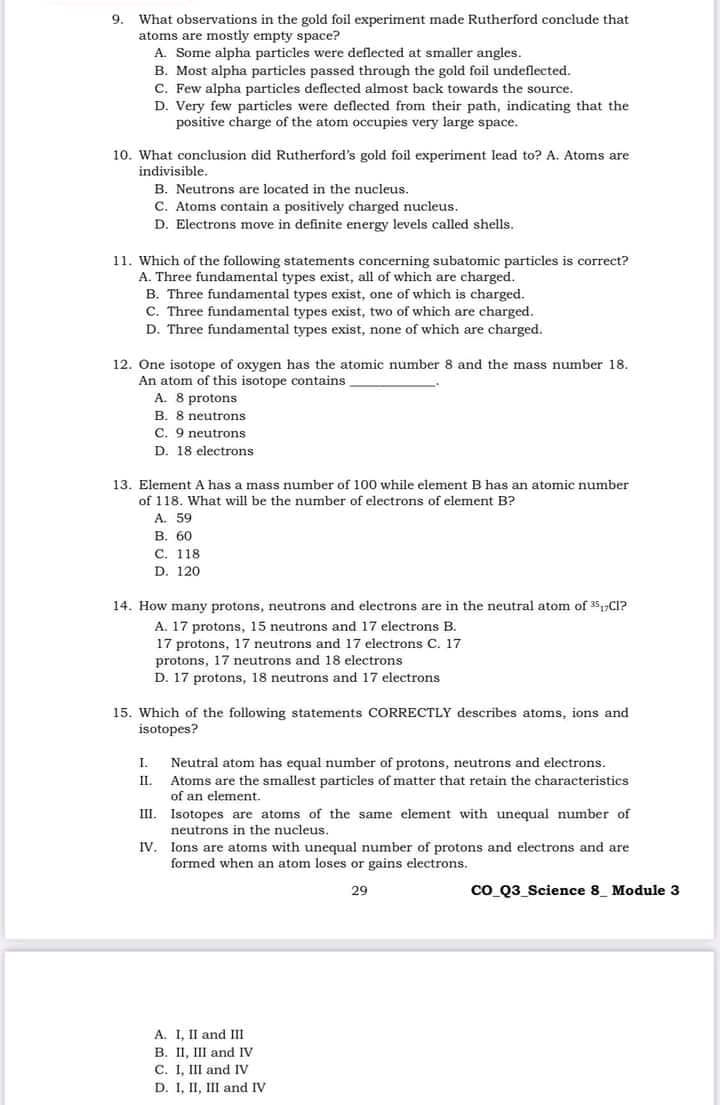9. What observations in the gold foil experiment made Rutherford conclude that atoms are mostly empty space? A. Some alpha particles were deflected at smaller angles. B. Most alpha particles passed through the gold foil undeflected. C. Few alpha particles deflected almost back towards the source. D. Very few particles were deflected from their path, indicating that the positive charge of the atom occupies very large space. 10. What conclusion did Rutherford's gold foil experiment lead to? A. Atoms are indivisible. B. Neutrons are located in the nucleus. C. Atoms contain a positively charged nucleus. D. Electrons move in definite energy levels called shells. 11. Which of the following statements concerning subatomic particles is correct? A. Three fundamental types exist, all of which are charged. B. Three fundamental types exist, one of which is charged. C. Three fundamental types exist, two of which are charged. D. Three fundamental types exist, none of which are charged.
9. What observations in the gold foil experiment made Rutherford conclude that atoms are mostly empty space? A. Some alpha particles were deflected at smaller angles. B. Most alpha particles passed through the gold foil undeflected. C. Few alpha particles deflected almost back towards the source. D. Very few particles were deflected from their path, indicating that the positive charge of the atom occupies very large space. 10. What conclusion did Rutherford's gold foil experiment lead to? A. Atoms are indivisible. B. Neutrons are located in the nucleus. C. Atoms contain a positively charged nucleus. D. Electrons move in definite energy levels called shells. 11. Which of the following statements concerning subatomic particles is correct? A. Three fundamental types exist, all of which are charged. B. Three fundamental types exist, one of which is charged. C. Three fundamental types exist, two of which are charged. D. Three fundamental types exist, none of which are charged.
College Physics
10th Edition
ISBN:9781285737027
Author:Raymond A. Serway, Chris Vuille
Publisher:Raymond A. Serway, Chris Vuille
Chapter28: Atomic Physics
Section: Chapter Questions
Problem 5P
Related questions
Question
9 10 11
Letter only

Transcribed Image Text:9.
What observations in the gold foil experiment made Rutherford conclude that
atoms are mostly empty space?
A. Some alpha particles were deflected at smaller angles.
B. Most alpha particles passed through the gold foil undeflected.
C. Few alpha particles deflected almost back towards the source.
D. Very few particles were deflected from their path, indicating that the
positive charge of the atom occupies very large space.
10. What conclusion did Rutherford's gold foil experiment lead to? A. Atoms are
indivisible.
B. Neutrons are located in the nucleus.
C. Atoms contain a positively charged nucleus.
D. Electrons move in definite energy levels called shells.
11. Which of the following statements concerning subatomic particles is correct?
A. Three fundamental types exist, all of which are charged.
B. Three fundamental types exist, one of which is charged.
C. Three fundamental types exist, two of which are charged.
D. Three fundamental types exist, none of which are charged.
12. One isotope of oxygen has the atomic number 8 and the mass number 18.
An atom of this isotope contains
A. 8 protons
B. 8 neutrons
C. 9 neutrons
D. 18 electrons
13. Element A has a mass number of 100 while element B has an atomic number
of 118. What will be the number of electrons of element B?
A. 59
В. 60
С. 118
D. 120
14. How many protons, neutrons and electrons are in the neutral atom of 35,C1?
A. 17 protons, 15 neutrons and 17 electrons B.
17 protons, 17 neutrons and 17 electrons C. 17.
protons, 17 neutrons and 18 electrons
D. 17 protons, 18 neutrons and 17 electrons
15. Which of the following statements CORRECTLY describes atoms, ions and
isotopes?
I.
Neutral atom has equal number of protons, neutrons and electrons.
II. Atoms are the smallest particles of matter that retain the characteristics
of an element.
III. Isotopes are atoms of the same element with unequal number of
neutrons in the nucleus.
IV. Ions are atoms with unequal number of protons and electrons and are
formed when an atom loses or gains electrons.
29
co Q3_Science 8_ Module 3
A. 1, II and III
B. II, III and IV
C. I, III and IV
D. 1, II, III and IV
Expert Solution
This question has been solved!
Explore an expertly crafted, step-by-step solution for a thorough understanding of key concepts.
This is a popular solution!
Trending now
This is a popular solution!
Step by step
Solved in 2 steps with 2 images

Knowledge Booster
Learn more about
Need a deep-dive on the concept behind this application? Look no further. Learn more about this topic, physics and related others by exploring similar questions and additional content below.Recommended textbooks for you

College Physics
Physics
ISBN:
9781285737027
Author:
Raymond A. Serway, Chris Vuille
Publisher:
Cengage Learning

College Physics
Physics
ISBN:
9781305952300
Author:
Raymond A. Serway, Chris Vuille
Publisher:
Cengage Learning

College Physics
Physics
ISBN:
9781938168000
Author:
Paul Peter Urone, Roger Hinrichs
Publisher:
OpenStax College

College Physics
Physics
ISBN:
9781285737027
Author:
Raymond A. Serway, Chris Vuille
Publisher:
Cengage Learning

College Physics
Physics
ISBN:
9781305952300
Author:
Raymond A. Serway, Chris Vuille
Publisher:
Cengage Learning

College Physics
Physics
ISBN:
9781938168000
Author:
Paul Peter Urone, Roger Hinrichs
Publisher:
OpenStax College


Horizons: Exploring the Universe (MindTap Course …
Physics
ISBN:
9781305960961
Author:
Michael A. Seeds, Dana Backman
Publisher:
Cengage Learning

An Introduction to Physical Science
Physics
ISBN:
9781305079137
Author:
James Shipman, Jerry D. Wilson, Charles A. Higgins, Omar Torres
Publisher:
Cengage Learning